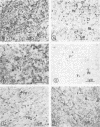Abstract
Recent publications have indicated that a KCl-stimulated ATPase from cereal roots is specifically associated with plasmalemma-enriched membrane fractions. However, in previous work we found that relatively high specific activities of this enzyme were also associated with a membrane fraction which did not contain plasmalemma. In an attempt to clarify this discrepancy, we have investigated the effect of density gradient composition upon the association of the enzyme with different membrane fractions isolated from the roots of Zea mays L. (WF9 × M14).
When roots were fractionated on a single, discontinuous sucrose density gradient the KCl-stimulated ATPase activity was concentrated in membrane fractions of relatively high density (σ = 1.17−1.22) which were enriched in plasmalemma. When fractions were isolated on both Ficoll and sucrose density gradients, KCl-stimulated ATPase activity was again found associated with plasmalemma and also in a second membrane fraction which did not contain plasmalemma. This fraction was found at relatively low densities (σ = 1.08) on the Ficoll gradient. The precise identity of the membrane in this fraction could not be determined.
A preliminary investigation into the properties of the two KCl-stimulated ATPase activities indicated that both had acid pH maxima and both displayed similar responses to changes in KCl concentration.
Full text
PDF







Images in this article
Selected References
These references are in PubMed. This may not be the complete list of references from this article.
- BUELL M. V., LOWRY O. H., ROBERTS N. R., CHANG M. L., KAPPHAHN J. I. The quantitative histochemistry of the brain. V. Enzymes of glucose metabolism. J Biol Chem. 1958 Jun;232(2):979–993. [PubMed] [Google Scholar]
- Epstein E., Rains D. W., Elzam O. E. RESOLUTION OF DUAL MECHANISMS OF POTASSIUM ABSORPTION BY BARLEY ROOTS. Proc Natl Acad Sci U S A. 1963 May;49(5):684–692. doi: 10.1073/pnas.49.5.684. [DOI] [PMC free article] [PubMed] [Google Scholar]
- Fisher J. D., Hansen D., Hodges T. K. Correlation between ion fluxes and ion-stimulated adenosine triphosphatase activity of plant roots. Plant Physiol. 1970 Dec;46(6):812–814. doi: 10.1104/pp.46.6.812. [DOI] [PMC free article] [PubMed] [Google Scholar]
- Hardin J. W., Cherry J. H., Morré D. J., Lembi C. A. Enhancement of RNA polymerase activity by a factor released by auxin from plasma membrane. Proc Natl Acad Sci U S A. 1972 Nov;69(11):3146–3150. doi: 10.1073/pnas.69.11.3146. [DOI] [PMC free article] [PubMed] [Google Scholar]
- Hodges T. K., Leonard R. T., Bracker C. E., Keenan T. W. Purification of an ion-stimulated adenosine triphosphatase from plant roots: association with plasma membranes. Proc Natl Acad Sci U S A. 1972 Nov;69(11):3307–3311. doi: 10.1073/pnas.69.11.3307. [DOI] [PMC free article] [PubMed] [Google Scholar]
- LOWRY O. H., ROSEBROUGH N. J., FARR A. L., RANDALL R. J. Protein measurement with the Folin phenol reagent. J Biol Chem. 1951 Nov;193(1):265–275. [PubMed] [Google Scholar]
- Leonard R. T., Hansen D., Hodges T. K. Membrane-bound Adenosine Triphosphatase Activities of Oat Roots. Plant Physiol. 1973 Apr;51(4):749–754. doi: 10.1104/pp.51.4.749. [DOI] [PMC free article] [PubMed] [Google Scholar]
- Leonard R. T., Hanson J. B. Increased Membrane-bound Adenosine Triphosphatase Activity Accompanying Development of Enhanced Solute Uptake in Washed Corn Root Tissue. Plant Physiol. 1972 Mar;49(3):436–440. doi: 10.1104/pp.49.3.436. [DOI] [PMC free article] [PubMed] [Google Scholar]
- Leonard R. T., Hodges T. K. Characterization of Plasma Membrane-associated Adenosine Triphosphase Activity of Oat Roots. Plant Physiol. 1973 Jul;52(1):6–12. doi: 10.1104/pp.52.1.6. [DOI] [PMC free article] [PubMed] [Google Scholar]
- Roland J. C., Lembi C. A., Morré D. J. Phosphotungstic acid-chromic acid as a selective electron-dense stain for plasma membranes of plant cells. Stain Technol. 1972 Jul;47(4):195–200. doi: 10.3109/10520297209116484. [DOI] [PubMed] [Google Scholar]
- Steck T. L., Straus J. H., Wallach D. F. A model for the behavior of vesicles in density gradients: implications for fractionation. Biochim Biophys Acta. 1970 Jun 2;203(3):385–393. doi: 10.1016/0005-2736(70)90179-3. [DOI] [PubMed] [Google Scholar]
- Torii K., Laties G. G. Dual mechanisms of ion uptake in relation to vacuolation in corn roots. Plant Physiol. 1966 May;41(5):863–870. doi: 10.1104/pp.41.5.863. [DOI] [PMC free article] [PubMed] [Google Scholar]
- Williamson F. A., Jones R. G. The isolation of plant root protoplasts and their use in the separation of subcellular components. Biochem J. 1971 Jun;123(2):4P–5P. doi: 10.1042/bj1230004pb. [DOI] [PMC free article] [PubMed] [Google Scholar]





